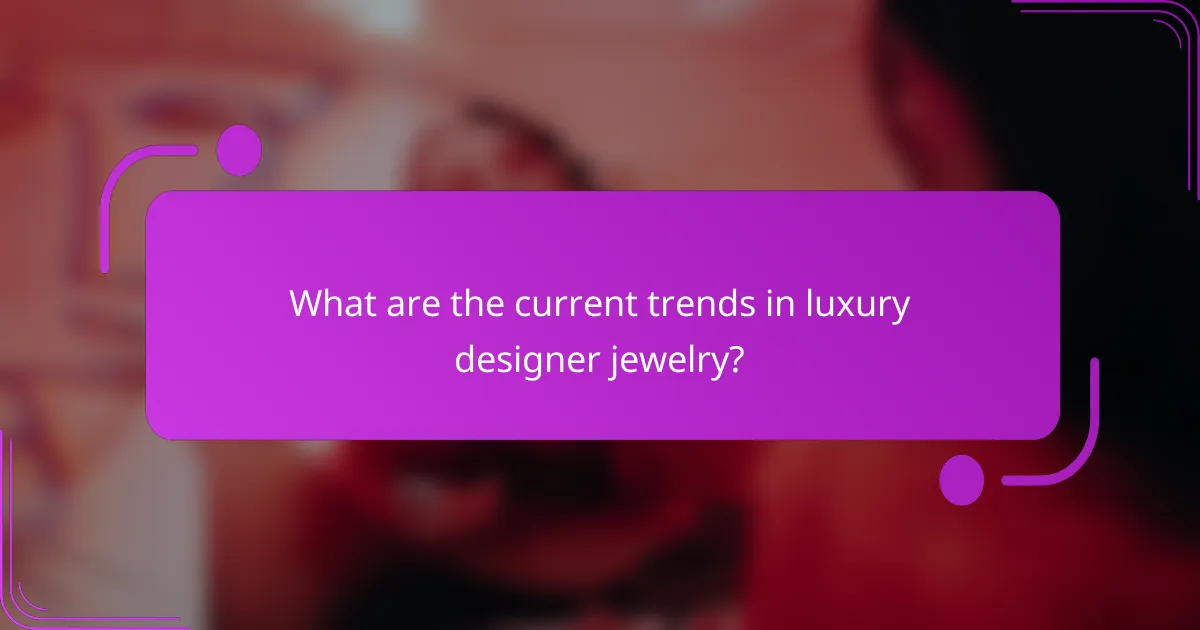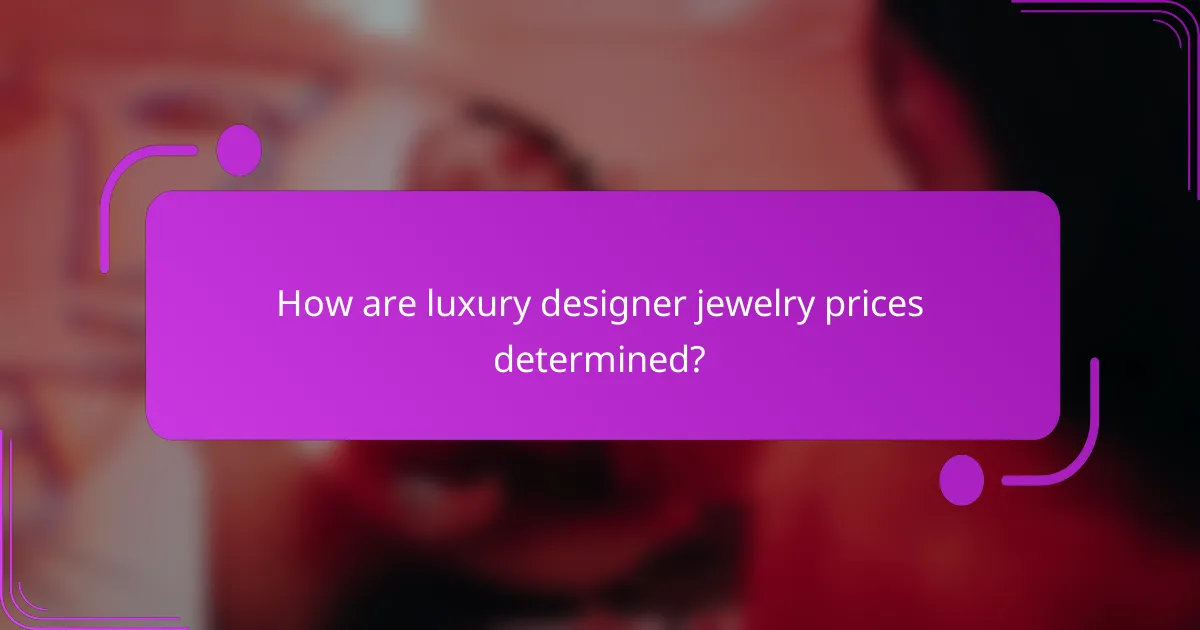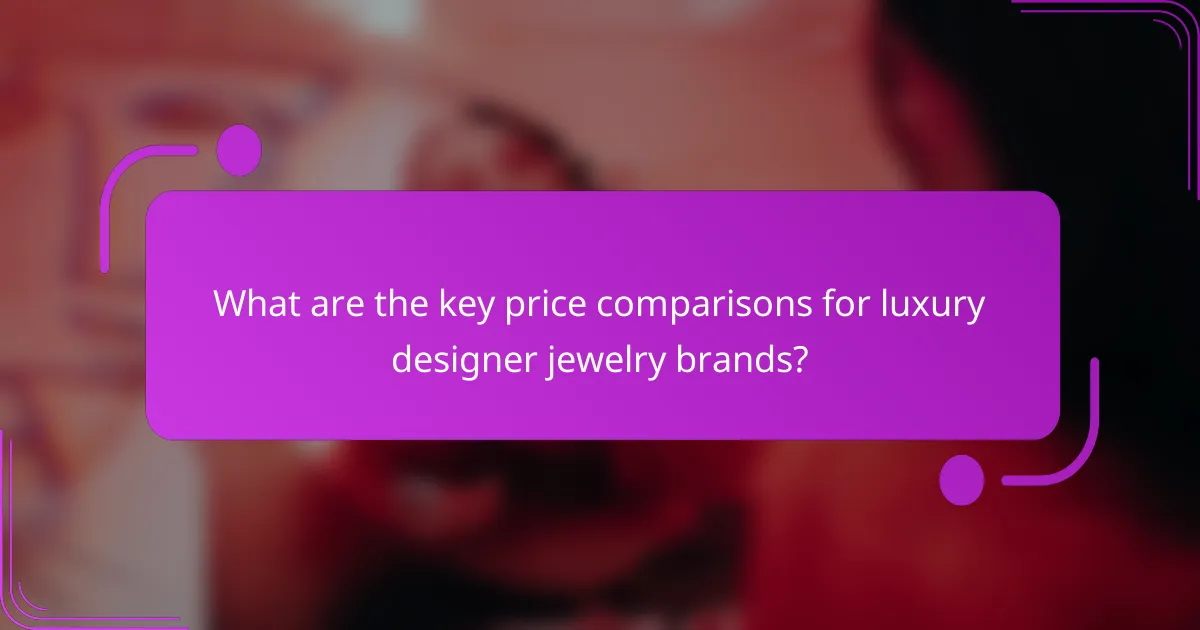Luxury designer jewelry is characterized by current trends such as personalization, sustainable materials, and bold statement pieces. Personalization enables consumers to design unique items, while sustainable practices involve the use of ethically sourced gemstones and recycled metals. The market also sees a resurgence of vintage styles, appealing to those seeking uniqueness and history. Pricing for luxury designer jewelry is influenced by factors including materials, craftsmanship, brand reputation, and market demand, with significant variations among brands. For example, entry-level pieces from Tiffany & Co. start around $1,000, while high-end items from Cartier can exceed $100,000, reflecting both brand prestige and consumer demand.

What are the current trends in luxury designer jewelry?
Current trends in luxury designer jewelry include personalization, sustainable materials, and bold statement pieces. Personalization allows consumers to create unique designs that reflect their individual style. Sustainable materials are increasingly popular, with brands sourcing ethically mined gemstones and recycled metals. Bold statement pieces often feature oversized designs and vibrant colors, making them focal points in any outfit. Additionally, vintage and antique styles are seeing a resurgence, appealing to consumers’ desire for uniqueness and history. These trends reflect a shift towards individuality and ethical considerations in luxury jewelry purchasing.
How do fashion trends influence luxury designer jewelry choices?
Fashion trends significantly influence luxury designer jewelry choices. Designers often align their collections with current fashion movements. This alignment ensures that the jewelry complements the latest apparel styles. For instance, during the rise of minimalism, jewelry became more understated and sleek. Conversely, bold and statement pieces emerged during fashion’s maximalist phases.
Consumer preferences shift in response to these trends. Research indicates that 70% of luxury buyers consider fashion trends when purchasing jewelry. Additionally, social media platforms amplify these influences. Influencers and celebrities showcase jewelry that aligns with prevailing trends. This visibility drives demand for specific styles and designs.
As a result, luxury brands adapt their offerings to meet these evolving consumer tastes. They often release limited edition pieces that reflect current fashion trends. This strategy not only boosts sales but also enhances brand relevance in a competitive market.
What are the most popular materials used in luxury designer jewelry today?
The most popular materials used in luxury designer jewelry today include gold, platinum, diamonds, and gemstones. Gold is favored for its durability and luster. Platinum is known for its rarity and strength. Diamonds remain a classic choice for their brilliance and value. Gemstones such as sapphires, emeralds, and rubies add color and uniqueness to designs. According to a report by Bain & Company, the demand for these materials has increased significantly in recent years, reflecting consumer preferences for high-quality, luxurious items.
Which design styles are trending in luxury jewelry collections?
Contemporary minimalism and bold statement pieces are trending in luxury jewelry collections. Contemporary minimalism focuses on clean lines and understated elegance. Designers are using high-quality materials to create simple yet sophisticated designs. Bold statement pieces feature intricate details and vibrant gemstones. These designs often incorporate unexpected shapes and asymmetry. Sustainability is also influencing trends, with many brands using ethically sourced materials. The combination of these styles reflects a shift towards personal expression and individuality in luxury jewelry.
What role do celebrity endorsements play in luxury jewelry trends?
Celebrity endorsements significantly influence luxury jewelry trends. They enhance brand visibility and desirability. When a celebrity wears a specific jewelry piece, it often leads to increased consumer interest. For instance, high-profile events like award shows showcase luxury jewelry on celebrities. This visibility can result in spikes in sales for featured brands. Research indicates that 70% of consumers trust celebrity endorsements when making luxury purchases. Additionally, social media amplifies this effect, as followers often seek to emulate their favorite stars. The combination of celebrity influence and social media creates a powerful marketing dynamic in the luxury jewelry sector.
How can consumers identify trends from celebrity jewelry choices?
Consumers can identify trends from celebrity jewelry choices by observing red carpet events and social media platforms. Celebrities often showcase unique and high-end pieces during these occasions. Tracking their jewelry selections can reveal popular styles, materials, and designers. Fashion magazines and online publications frequently highlight these choices, providing context and analysis. Additionally, jewelry brands often collaborate with celebrities for promotional campaigns, influencing consumer preferences. Data from social media engagement can indicate which styles gain traction among followers. This collective information helps consumers stay informed about emerging trends in luxury designer jewelry.
What impact do social media platforms have on luxury jewelry trends?
Social media platforms significantly influence luxury jewelry trends. They provide a space for brands to showcase their collections. Visual platforms like Instagram and Pinterest drive consumer engagement. Influencers play a crucial role in shaping perceptions of luxury jewelry. Their endorsements can lead to increased demand for specific pieces. Data shows that 70% of millennials are influenced by social media when making luxury purchases. Additionally, trends often emerge from viral content shared online. Social media also facilitates direct interaction between brands and consumers, enhancing brand loyalty.

How are luxury designer jewelry prices determined?
Luxury designer jewelry prices are determined by several key factors. These include the materials used, craftsmanship, brand reputation, and market demand. High-quality materials like precious metals and gemstones significantly increase the price. Expert craftsmanship adds to the cost due to the skill and time invested in creating each piece. Brand reputation plays a crucial role; renowned designers command higher prices due to their established status and desirability. Additionally, market demand influences pricing; limited editions or unique designs often sell for a premium. These factors collectively establish the pricing structure within the luxury jewelry market.
What factors contribute to the pricing of luxury designer jewelry?
The pricing of luxury designer jewelry is influenced by several key factors. First, the quality of materials significantly affects the price. Precious metals and gemstones are costly and rare. Second, brand reputation plays a crucial role. Renowned designers command higher prices due to their established prestige. Third, craftsmanship is essential. Handcrafted pieces often require more time and skill, increasing costs. Fourth, exclusivity adds value. Limited edition items or unique designs can fetch higher prices. Fifth, market demand impacts pricing. Trends and consumer preferences can drive up prices for certain styles. Lastly, provenance can enhance value. Jewelry with a notable history or celebrity association often commands a premium.
How do brand reputation and heritage affect jewelry prices?
Brand reputation and heritage significantly influence jewelry prices. High-end brands with a strong reputation command premium prices. This is due to perceived quality and exclusivity associated with their heritage. For example, brands like Cartier and Tiffany & Co. have established trust over decades. Their historical significance adds value to their pieces. Additionally, heritage brands often utilize superior materials and craftsmanship. This further justifies higher price points. According to a 2022 market analysis, luxury jewelry prices can be 20-50% higher for brands with strong reputations compared to lesser-known labels. Thus, brand reputation and heritage are critical factors in determining jewelry pricing.
What role does craftsmanship play in the cost of luxury jewelry?
Craftsmanship significantly impacts the cost of luxury jewelry. High-quality craftsmanship ensures that each piece is meticulously designed and created. This process involves skilled artisans who use advanced techniques and tools. The precision in craftsmanship enhances the overall aesthetic appeal and durability of the jewelry. Luxury brands often emphasize artisanal methods, which require extensive training and experience. For instance, handmade pieces typically command higher prices than mass-produced items. Additionally, intricate details and custom designs further elevate costs. The value of craftsmanship reflects both the time invested and the expertise required to create exquisite jewelry.
How do seasonal sales and market demand influence jewelry prices?
Seasonal sales and market demand significantly influence jewelry prices. During peak seasons, such as holidays or wedding seasons, demand for jewelry typically increases. This heightened demand can lead to higher prices as retailers capitalize on consumer willingness to spend. Conversely, during off-peak seasons, demand may decrease, resulting in lower prices as retailers seek to clear inventory.
For example, a study by the National Retail Federation indicates that jewelry sales often spike by 20% during the holiday season. Retailers may also offer discounts during slower months to attract buyers. Price fluctuations are thus directly correlated with seasonal trends and consumer purchasing behavior.
What are the typical price ranges for different types of luxury jewelry?
Typical price ranges for luxury jewelry vary significantly. Fine jewelry often ranges from $1,000 to $50,000. High-end designer pieces can range from $5,000 to $500,000. Custom-made luxury items may exceed $1 million. Precious gemstones, like diamonds, significantly influence pricing. For example, a 1-carat diamond ring can cost between $2,000 and $20,000. Gold jewelry typically ranges from $500 to $10,000, depending on design and craftsmanship. Overall, the market for luxury jewelry is diverse and influenced by brand reputation, materials, and rarity.
How can consumers find the best deals on luxury designer jewelry?
Consumers can find the best deals on luxury designer jewelry by comparing prices across multiple retailers. Online platforms like PriceGrabber and ShopSavvy aggregate prices from various stores. Signing up for newsletters from luxury brands can provide exclusive discounts and early access to sales. Utilizing social media can also reveal flash sales or promotions. Additionally, attending seasonal sales events can lead to significant savings. Research indicates that shopping during off-peak seasons can yield lower prices. Lastly, considering pre-owned or vintage jewelry can offer high-quality pieces at reduced costs.

What are the key price comparisons for luxury designer jewelry brands?
Key price comparisons for luxury designer jewelry brands vary significantly. For instance, Tiffany & Co. offers engagement rings starting around $1,000. Cartier’s entry-level pieces begin at approximately $2,500. Chanel jewelry typically starts at about $3,000. Bvlgari’s signature items often start near $1,500. Prices can escalate dramatically based on materials and craftsmanship. High-end pieces from these brands can reach tens of thousands of dollars. For example, exceptional diamond rings from Cartier can exceed $100,000. These price ranges reflect brand prestige and market demand.
How do prices vary between different luxury jewelry brands?
Prices vary significantly between different luxury jewelry brands. Factors influencing these price variations include brand reputation, materials used, and craftsmanship. For instance, brands like Cartier and Tiffany & Co. often command higher prices due to their prestigious history and iconic designs. In contrast, newer luxury brands may offer similar quality but at lower price points to attract customers.
The price range for luxury jewelry can start from a few thousand dollars and extend to tens of thousands or more for high-end pieces. For example, a simple diamond ring from a well-known brand may start at around $5,000. Meanwhile, elaborate designs with rare gemstones can exceed $100,000.
Market research indicates that the average price for luxury jewelry items has increased by approximately 10% annually over the past five years. This trend reflects growing demand and inflation in precious materials. Overall, the luxury jewelry market showcases a wide price spectrum influenced by various brand-specific attributes.
What are the most expensive luxury jewelry brands, and why?
The most expensive luxury jewelry brands include Cartier, Tiffany & Co., Bulgari, Van Cleef & Arpels, and Graff. These brands are known for their exquisite craftsmanship and high-quality materials. Cartier is renowned for its iconic designs and royal clientele. Tiffany & Co. is famous for its timeless elegance and the signature blue box. Bulgari is celebrated for its bold, colorful gemstones and Italian artistry. Van Cleef & Arpels is recognized for its intricate designs and innovative techniques. Graff specializes in rare diamonds and exceptional quality. The high prices of these brands reflect their heritage, craftsmanship, and exclusivity in the luxury market.
How do emerging luxury brands compare in pricing to established ones?
Emerging luxury brands generally offer lower pricing compared to established luxury brands. Established brands often have a long history and strong brand equity, which allows them to command higher prices. For instance, iconic brands like Chanel and Louis Vuitton can price items significantly higher due to their reputation and craftsmanship. In contrast, emerging brands may price their products competitively to attract consumers and build market presence. This pricing strategy helps them gain traction in a crowded market. A study by Bain & Company indicates that emerging luxury brands are increasing their market share by appealing to younger consumers who seek affordable luxury options.
What are the best practices for comparing luxury jewelry prices?
To compare luxury jewelry prices effectively, research multiple retailers and online platforms. Check for price variations across authorized dealers and secondary markets. Analyze the quality and craftsmanship of the jewelry, as these factors influence pricing. Look for certifications and appraisals that validate the jewelry’s value. Utilize price comparison tools and websites dedicated to luxury goods. Monitor seasonal sales and promotions that may affect pricing. Consult expert reviews and consumer feedback for insights on pricing trends. This approach ensures informed purchasing decisions in the luxury jewelry market.
How can consumers effectively evaluate the value of luxury jewelry pieces?
Consumers can effectively evaluate the value of luxury jewelry pieces by assessing quality, brand reputation, and market trends. Quality can be determined by examining materials, craftsmanship, and design intricacies. For instance, high-quality gemstones should have superior clarity, color, and cut. The brand reputation plays a crucial role; established luxury brands often maintain value due to their heritage and craftsmanship. Market trends influence value as well; understanding current demand for specific styles or materials can impact resale value. Research shows that luxury jewelry retains value better when sourced from renowned brands and crafted with high-quality materials.
What tips can help consumers make informed purchasing decisions in luxury jewelry?
To make informed purchasing decisions in luxury jewelry, consumers should research brands and their reputations. Understanding the quality of materials used is crucial. Consumers should also inquire about certifications for gemstones. Comparing prices across different retailers helps identify fair market value. Additionally, consumers should evaluate the craftsmanship and design details. Reading reviews from other buyers provides insight into the product’s quality. Lastly, considering return policies and warranties ensures consumer protection. These tips empower consumers to make educated choices in the luxury jewelry market.
Luxury designer jewelry is characterized by current trends such as personalization, sustainable materials, and bold statement pieces. The article explores how fashion trends and celebrity endorsements shape consumer choices, detailing popular materials and design styles in the luxury market. It also examines the factors determining jewelry prices, including craftsmanship, brand reputation, and market demand, while providing insights on price comparisons among established and emerging luxury brands. Additionally, tips for consumers on evaluating jewelry value and making informed purchasing decisions are included.